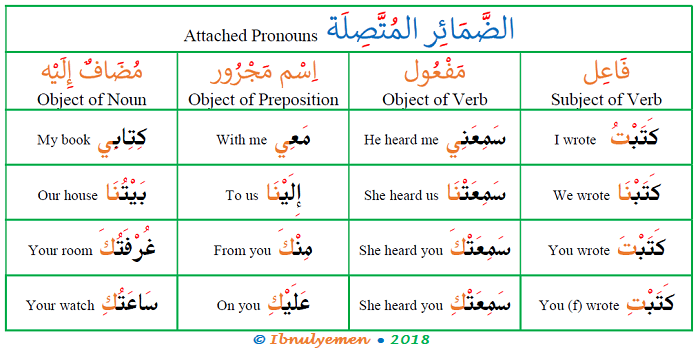Arabic Attached Pronouns Posted by Ibnulyemen اِبْنُ اليَمَن on Oct 23, 2018 in Grammar, Vocabulary
الضَّمِيْر ‘the pronoun’ in Arabic is either overt or covert. The covert is called مُسْتَتِر, and it is neither written nor pronounced. The overt is called ظَاهِر, and it can be separate مُنْفَصِل or attached مُتَّصِل. This post is primarily about the attached pronouns in Arabic.

الضَّمِيْرُ المُنْفَصِل The Separate Pronoun:
الضَّمِيْر المُنْفَصِل ‘the separate pronoun’ refers to a person, hence called the personal pronoun. There are twelve personal pronouns in Arabic classified into three types: first person, second person, and third person, as summarized below:
|
مُتَكَلِّم first person |
مُخَاطَب second person |
غَائِب third person |
|
أَنَا نَحْنُ |
أَنْتَ أَنْتِ أَنْتُما أَنْتُم أَنْتُنَّ |
هُوَ هِيَ هُمَا هُم هُنَّ |
الضَّمِيْرُ المُسْتَتِر The Covert Pronoun:
الضَّمِيْر المُسْتَتِر ‘the covert pronoun’ is associated with verbs: the perfective المَاضِي and imperfective المُضَارِع (as well as the imperative الأَمْر). Of the twelve separate pronouns, only five pronouns are covert. These are: هُو, هِيَ, أَنَا, نَحْنُ, and أَنْتَ. Of these, هُوَ and هِيَ do not appear after both the perfective and the imperfective forms of the verb, while أَنَا, نَحْنُ, and أَنْتَ do not appear after the imperfective forms of the verb.
| الضَّمِيْر the pronoun | المَاضِي the perfective | المُضَارِع the imperfective |
| هُوَ | نَظَرَ* | يَنْظُر* |
| هِيَ | نَظَرَتْ* | تَنْظُر* |
| أَنَا | أَنْظُر* | نَظَرْتُ |
| نَحْنُ | نَنْظُر* | نَظَرْنَا |
| أَنْتَ | تَنْظُر* | نَظَرْتَ |
In the table above, the asterisk (*) indicates that the subject pronoun of the verb is covert (i.e. implicit). Note that the taa’ with sukuun تْ in نَظَرَتْ is not a pronoun. Rather, it is the feminine marker. The subjects of the verbs with no asterisk is overt (i.e. attached). In نَظَرْتُ, the subject is تُ; in نَظَرْنَا, it is نَا; and in نَظَرْتَ, it is تَ.
الضَّمِيْرُ المُتَّصِل The attached Pronoun:
Attached pronouns are always added to the end of the word. This word can be a verb, a noun, or a preposition. When added to a verb, it functions as a subject فَاعِل or as an object مَفْعُول. If added to a noun, it is a possessive pronoun مُضَاف إِلَيْهِ. And if appended to a preposition, it functions as an object of a preposition اِسْم مَجْرُور.
|
فَاعِل Subject of Verb |
مَفْعُول Object of Verb |
اِسْم مَجْرُور Object of Preposition |
مُضَافٌ إِلَيْه Object of Noun |
| كَتَبْـتُ I wrote | سَمِعَنِـي He heard me | مَعِــي with me | كِتِابِــي my book |
| كَتَبْـنَا we wrote | سَمِعَتْـنَا she heard us | إِلَيْـنا to us | بَيْتُــنَا our house |
| كَتَبْـتَ you (m, s) wrote | سَمِعَتْـكَ she hear you | مِنْـكَ from you | غُرْفَتُـكَ your room |
| كَتَبْـتِ you (f, s) wrote | سَمِعَتْـكِ she hear you | عَلَيْـكِ on you | سَاعَتُـكِ your watch |
| كَتَبْـتُمَا you (d) wrote | سَمِعَتْـكُمَا she heard you | مَعَـكُمَا with you | كِتَابُـكُمَا your book |
| كَتَبْـتُم you (p, m) wrote | سَمِعَتْـكُم she heard you | عَلَيْـكُم on you | بَيْتُـكُم your house |
| كَتَبْـتُنَّ you (p, f) wrote | سَمْعَتْـكُنَّ she hear you | عَلَيْـكُنَّ on you | بَيْتُـكُنَّ your house |
| كَتَبَ* he wrote | سَمِعَتْــه she heard him | بِــهِ by him | قَلَمُــهُ his pen |
| كَتَبَتْ* she wrote | سَمِعَتْــها she heard her | بِــهَا by her | قَلَمُــهَا her pen |
| كَتَبَـا both (m, d) wrote | سَمِعَتْــهُمَا she heard both | بِــهِمَا from both of them | قَلَمُــهُمَا their pen |
| كَتَبَتَـا both (f, d) wrote | سَمِعَتْــهُمَا she heard both | بِــهِمَا from both of them | قَلَمُــهُمَا their pen |
| كَتَبُـوا they (m, p) wrote | سَمِعَتْــهُم she heard them | عَلَيْــهِم on them | بَيْتُــهُم their house |
| كَتَبْـنَ they (m, f) wrote | سَمْعَتْــهُنَّ she heard them | مِنْــهُنَّ from them (f) | بَيْتُــهُنَّ their house |
| m = masculine, s = singular, f = feminine, p = plural, d = dual, * = covert pronoun | |||
You can download a complete summary of all attached pronouns here.
You can also try this short test.

Build vocabulary, practice pronunciation, and more with Transparent Language Online. Available anytime, anywhere, on any device.



